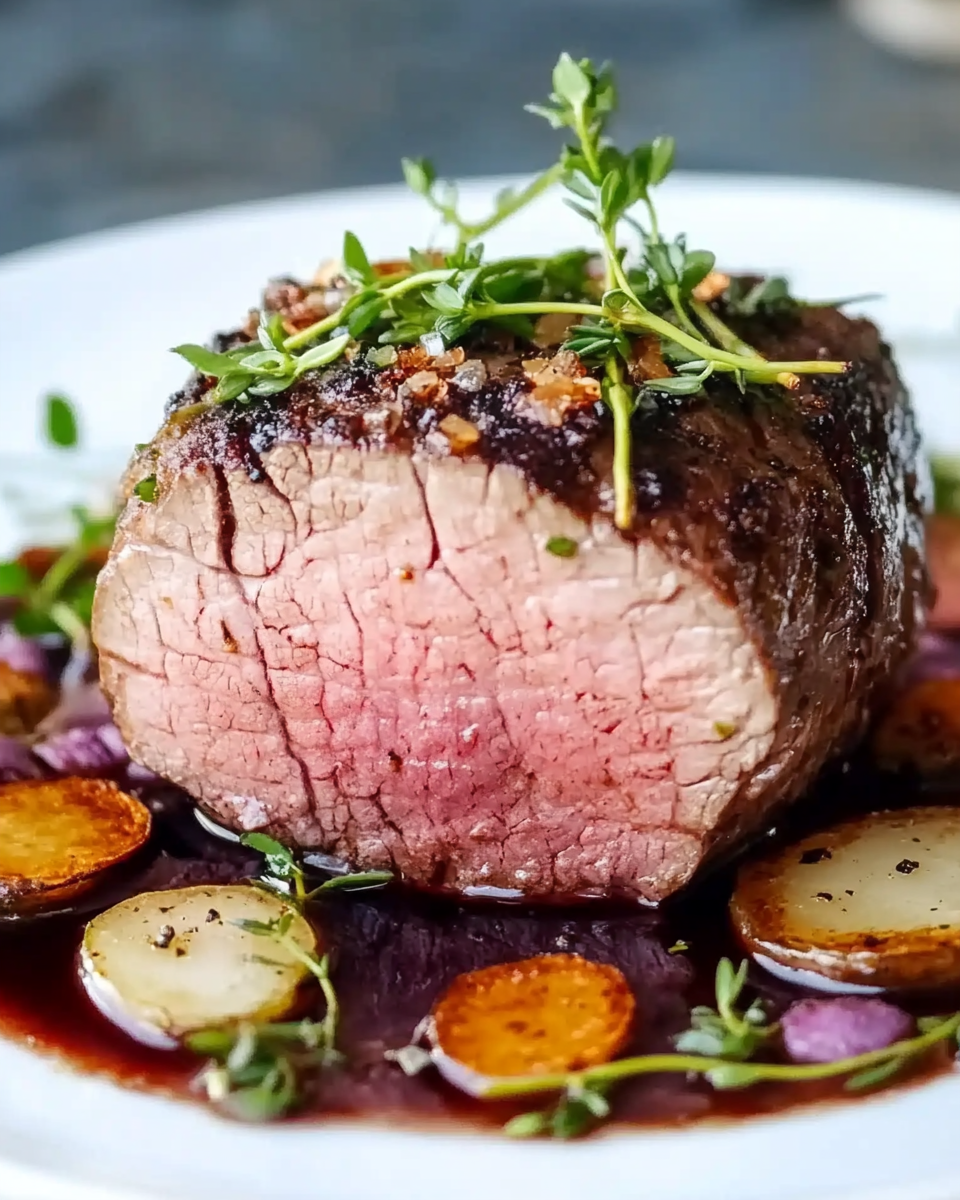Wine Roasted Beef Tenderloin is an elegant yet approachable dish that transforms a classic cut of beef into a showstopping centerpiece. Marinated in red wine, garlic, and herbs for 24 hours, the tenderloin becomes incredibly flavorful and tender. Finished with a peppery crust and roasted to perfection, it’s ideal for special occasions or a luxurious family dinner.
Full Recipe:
Ingredients
- 2 lbs beef tenderloin (preferably grass-fed organic)
- 1 cup red wine (e.g., Cabernet Sauvignon)
- 4 cloves garlic, minced
- 2 tablespoons olive oil
- 1 tablespoon fresh thyme leaves
- 1 tablespoon fresh rosemary, chopped
- 1 teaspoon sea salt
- 1 teaspoon freshly ground black pepper
- 2 tablespoons unsalted butter
- Optional: grape tomatoes for roasting alongside
Directions
- Marinate the Beef: In a large bowl, combine red wine, minced garlic, olive oil, thyme, and rosemary. Place the beef tenderloin in a resealable plastic bag or shallow dish and pour the marinade over it. Seal or cover and refrigerate for 24 hours, turning occasionally to ensure even marination.
- Preheat and Prepare: Remove the beef from the marinade and pat dry with paper towels. Let it sit at room temperature for about 1 hour. Preheat the oven to 425°F (220°C).
- Sear the Tenderloin: Heat a cast-iron skillet over medium-high heat. Season the beef with sea salt and black pepper. Sear the tenderloin on all sides until browned, about 3-4 minutes per side.
- Roast: Transfer the skillet to the preheated oven. Roast the beef for 20-25 minutes, or until the internal temperature reaches 130°F (54°C) for medium-rare. If desired, add grape tomatoes to the skillet for the last 10 minutes of roasting.
- Rest and Serve: Remove the beef from the oven and transfer to a cutting board. Tent with aluminum foil and let it rest for 15 minutes. Slice and serve with the roasted tomatoes and pan juices.
Nutritional Facts
Per serving (based on 6 servings):
- Calories: Approximately 350 kcal
- Protein: 35g
- Fat: 22g
- Saturated Fat: 8g
- Carbohydrates: 2g
- Sugars: 0g
- Fiber: 0g
- Cholesterol: 110mg
- Sodium: 400mg
The Role of Wine in Cooking Beef Tenderloin
Using red wine in cooking beef is a classic culinary technique that enhances the flavor profile of the dish. Wine acts as both a marinade and a cooking medium, imparting depth and a touch of sophistication. The tannins in red wine complement the natural fattiness of the beef, balancing richness with acidity. This interaction creates a harmonious blend of flavors that enhances the overall eating experience.
When you marinate beef tenderloin in wine, the alcohol and acids slowly penetrate the meat, helping to tenderize it and infuse it with complex notes that range from fruity to earthy, depending on the type of wine used. Cabernet Sauvignon, often recommended for this recipe, is a popular choice due to its full-bodied flavor and balanced tannins, which complement the beef without overpowering it.
Herbs and Aromatics: Adding Freshness and Complexity
Alongside the wine, fresh herbs such as thyme and rosemary play a crucial role in defining the character of this dish. These herbs release fragrant oils during the marination and roasting process, subtly seasoning the beef and adding layers of aromatic complexity. Garlic, with its robust and savory qualities, provides a pungent undertone that enhances the overall flavor profile.
The combination of garlic, rosemary, and thyme is a classic pairing for beef, rooted in centuries of culinary tradition. This blend works particularly well with the mild flavor of tenderloin, offering just enough seasoning to elevate the meat without overwhelming its natural taste.
The Art of Marination and Its Impact on Texture and Flavor
Marinating the beef tenderloin for an extended period — typically 24 hours — is essential to achieving the ideal balance of flavor and tenderness in this recipe. This slow marination allows the wine and herbs to fully permeate the meat, creating a more cohesive and rich taste throughout every bite.
Besides flavor infusion, marination plays a critical role in tenderizing the beef. The acids found in red wine gently break down muscle proteins, softening the meat’s fibers and enhancing its melt-in-your-mouth texture. This process also helps retain moisture during cooking, preventing the tenderloin from drying out and ensuring a juicy result.
Searing and Roasting: Techniques for Perfect Texture
The cooking method used in this recipe combines searing and roasting to produce a crusty exterior with a tender, juicy interior. Searing the beef on all sides in a hot skillet caramelizes the surface, developing a rich, brown crust that adds flavor and texture. This Maillard reaction — a chemical reaction between amino acids and reducing sugars — creates the deep, savory notes that make roasted meats so appealing.
Following the sear, roasting the tenderloin in the oven at a relatively high temperature finishes the cooking process evenly. Roasting allows the internal temperature of the meat to rise gently and uniformly, ensuring that the center reaches the desired doneness without overcooking the outer layers. The resting period after roasting is equally important, as it lets the juices redistribute throughout the meat, resulting in a moist and flavorful slice.
Pairing and Serving Suggestions
Wine Roasted Beef Tenderloin is a versatile dish that pairs beautifully with a variety of sides and sauces. The recipe itself often includes grape tomatoes roasted alongside the beef, which add a sweet and tangy contrast to the savory meat. Beyond this, classic accompaniments such as creamy mashed potatoes, roasted vegetables, or a fresh green salad complement the rich flavors of the tenderloin.
For sauces, a simple pan jus made from the roasting drippings can enhance the natural beef flavor without overpowering it. Alternatively, a red wine reduction or a mushroom cream sauce can add indulgent layers of taste to the meal. Wine Roasted Beef Tenderloin also pairs wonderfully with red wines such as Pinot Noir, Merlot, or Cabernet Sauvignon, which echo the flavors used in the marinade.
Nutritional Considerations
While beef tenderloin is a rich and indulgent dish, it also offers nutritional benefits. It is an excellent source of high-quality protein, essential for muscle growth and repair, and provides important vitamins and minerals such as iron, zinc, and B vitamins. These nutrients support various bodily functions, including energy metabolism and immune health.
However, because beef tenderloin has a moderate fat content — especially saturated fat — it is best enjoyed in moderation as part of a balanced diet. The wine marinade does not add significant calories but contributes antioxidants and flavor complexity without the need for excessive salt or heavy sauces.
Culinary Tips and Variations
For those looking to experiment with this recipe, there are several variations to consider. You can try different red wines, each bringing its unique flavor profile to the dish. For example, a Syrah might add a spicy note, while a Merlot could bring a softer, fruitier touch.
Herbs can also be adjusted based on preference — adding sage or oregano can introduce new aromatic elements. Some cooks like to add a touch of Dijon mustard or Worcestershire sauce to the marinade for an extra layer of flavor complexity.
Additionally, while the recipe recommends searing in a cast-iron skillet for best results, using a grill or oven-safe roasting pan can also work, offering a slightly different texture and smoky nuance.
The Cultural and Social Significance of Beef Tenderloin
Serving beef tenderloin at the table often symbolizes celebration and hospitality. Its reputation as a premium cut means it is frequently reserved for holidays, weddings, anniversaries, and other important gatherings. Sharing this dish can signify care, effort, and respect for guests, making it more than just a meal but an experience.
In many culinary traditions worldwide, roasting a whole tenderloin is considered a mark of skill and sophistication. It requires attention to detail and timing to cook perfectly, rewarding the cook with appreciative praise and satisfied diners.
Conclusion
Wine Roasted Beef Tenderloin is a timeless and luxurious dish that elevates a classic cut of beef with the sophisticated flavors of red wine, garlic, and fresh herbs. Its preparation emphasizes patience and technique — from the extended marination to the careful searing and roasting — culminating in a tender, juicy, and flavorful centerpiece perfect for special occasions.






